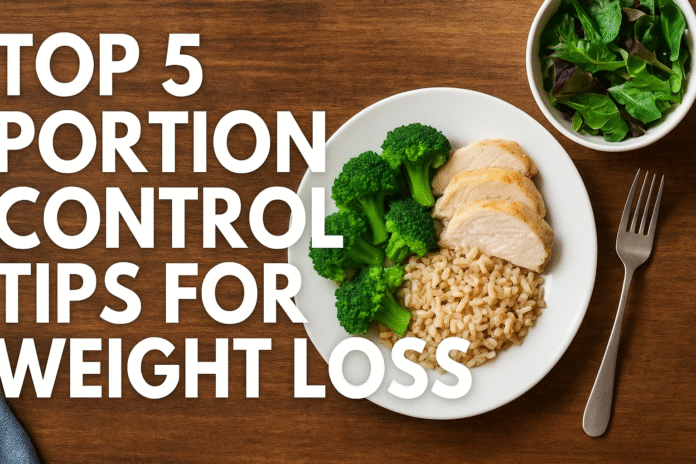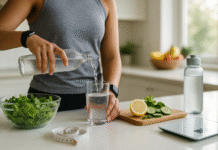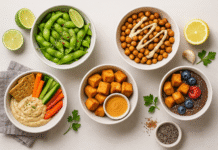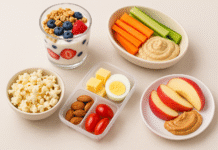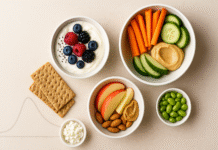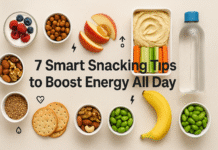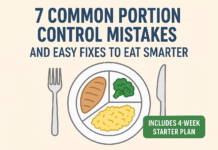Portion control is one of the simplest, highest-impact changes you can make to lose weight and keep it off. In the first 100 words: this article, Top 5 Portion Control Tips for Weight Loss, gives practical, evidence-based portion control strategies you can use today to cut excess calories, reshape habits, and achieve steady weight loss without extreme dieting. Read on for step-by-step instructions, beginner progressions, a ready-to-use 4-week plan, troubleshooting, measurement methods, and answers to common questions.
Medical disclaimer: This article provides general information about diet and portion control and is not medical advice. If you have a medical condition (including pregnancy, diabetes, eating disorders, or metabolic disease) or take prescription medications that affect appetite or weight, consult a qualified healthcare professional before making major changes.
Key takeaways
- Small tools, big impact: Changing plate size, measuring once, and pre-portioning food reliably reduces intake without hunger.
- Learn the visual rules: Hand and plate visuals let you estimate portions anywhere — no scale required.
- Speed and attention matter: Slow, mindful eating and removing distractions improve fullness signals and cut accidental overeating.
- Track progress simply: Weekly weigh-ins, waist measurements, and a short food log are accurate, low-effort KPIs.
- Make it sustainable: Combine portion control with more veggies, fewer energy-dense foods, and small, maintainable calorie deficits for lasting results.
Why portion control works (brief science + practical promise)
Over recent decades, portion sizes have grown dramatically and that environmental shift has led many people to unknowingly eat more than their bodies need. Larger portions increase total calories consumed, often without creating more satisfaction. The good news: reducing portion size — even modestly — reliably reduces calorie intake and produces steady weight loss when paired with reasonable daily habits. Portion control is not about deprivation; it’s about matching what you eat to your needs, shaping habits, and designing an environment that nudges the fork.
Top 5 Portion Control Tips (each tip is a complete mini-system)
Tip 1: Use smaller plates, bowls, and portion-control dishware
What it is and core benefits or purpose
Switching to smaller plates, bowls, and cups reduces the amount of food you serve and the visual cue that drives overeating. This “dishware nudge” works because people tend to fill a plate and eat what is served.
Requirements / prerequisites and low-cost alternatives
- Requirements: Any set of smaller plates and bowls, or a portion-control plate if you like a single-tool solution.
- Low-cost alternatives: Use a salad plate instead of a dinner plate, use a cereal bowl for dinner, or place a smaller plate on top of a larger one to make the meal appear larger without changing quantity.
Step-by-step instructions (beginner friendly)
- Replace your main dinner plate with a plate 8–9 inches across (salad or dessert plate size).
- Serve the same meal composition you normally do, but on the smaller plate. Don’t double-serve yet.
- Pause after serving for 90 seconds, breathe, then start eating slowly (pair with mindful eating from Tip 4).
- If still hungry after 20 minutes, wait 10 minutes and reassess before taking more.
Beginner modifications and progressions
- Modify (simplify): Start by using a smaller bowl for snacks only.
- Progress (scale up): Add a portion-control plate with printed divisions (half vegetables, quarter protein, quarter starch) and measure leftovers weekly.
Recommended frequency/duration/metrics
- Frequency: Use smaller dishware for all main meals (dinner, lunch) daily. Snacks optional.
- Metrics: Compare your plate-served portions vs previous servings once per week (photo before/after) and track change in weekly calories or weight.
Safety, caveats, common mistakes
- Caveat: Smaller plates can cause you to underestimate calories if you compensate with extra helpings or calorie-dense foods.
- Common mistake: Using smaller plates but filling them with high-calorie foods (e.g., nuts, cheese) — still leads to too many calories.
Mini sample plan (2–3 steps)
- For one week, eat all dinners on an 8-inch plate.
- Take a before/after photo of your usual dinner on an old plate vs new plate to see the visual difference.
- If you’re still hungry, add a cup of raw or cooked non-starchy vegetables rather than a second plate.
Tip 2: Measure and learn portion sizes (scale, cup, and hand methods)
What it is and core benefits or purpose
Measuring food with a kitchen scale, measuring cups, or hand/visual cues helps you learn what real portion sizes look like and prevents repeated over-serving. Once you internalize typical portions, you’ll be able to estimate quickly anywhere.
Requirements / prerequisites and low-cost alternatives
- Requirements: A digital kitchen scale (recommended) and a set of measuring cups/spoons.
- Low-cost alternatives: Use the “hand method” (palm = protein, fist = carbs, cupped hand = snacks, thumb = fats) or common objects (deck of cards, tennis ball, cupped fist).
Step-by-step instructions (beginner friendly)
- Buy an inexpensive digital kitchen scale (or use measuring cups).
- Weigh a common portion of protein (e.g., cooked chicken) to learn what 3–4 oz looks like on your plate. Record it.
- Repeat with ½ cup cooked rice, 1 cup cooked vegetables, 1 tbsp oil. Note the visual and tactile cues.
- Practice at least once per meal for 1–2 weeks until estimates feel natural.
Beginner modifications and progressions
- Modify: Start measuring just one meal per day (dinner).
- Progress: Move from measuring to purely visual estimates after 4 weeks; occasionally re-weigh to check accuracy.
Recommended frequency/duration/metrics
- Frequency: Measure daily while learning (2–3 weeks), then measure intermittently for maintenance.
- Metrics: Keep a short log of measured portions for a week to calculate average daily intake.
Safety, caveats, common mistakes
- Caveat: Measurement helps accuracy but obsessively weighing every crumb can increase anxiety for some people. Use measuring as training, not punishment.
- Common mistake: Measuring raw weight vs cooked weight inconsistently — choose one and be consistent.
Mini sample plan (2–3 steps)
- Week 1: Measure dinner protein and carbohydrate portions three times this week.
- Week 2: Use hand method for packed lunches; weigh one meal per week to cross-check.
Tip 3: Pre-portion, pack, and meal-prep for control and convenience
What it is and core benefits or purpose
Pre-portioning meals and snacks into containers reduces decision friction and eliminates “how much should I take?” moments that lead to overeating. It also makes healthy choices convenient when hunger hits.
Requirements / prerequisites and low-cost alternatives
- Requirements: A set of reusable containers (multiple 500–700 mL containers), a fridge, and labels.
- Low-cost alternatives: Use disposable containers for a week, resealable bags, or divide communal dishes into single-serve bowls before eating.
Step-by-step instructions (beginner friendly)
- Pick one day (e.g., Sunday) for a 30–60 minute prep window.
- Cook a simple protein (baked chicken or chickpeas) and a grain (brown rice or quinoa). Steam or roast a batch of vegetables.
- Portion meals into containers using the plate method: half veggies, quarter protein, quarter whole grains/starches. Add a separate small container for sauces/dressings.
- Store labeled containers for 3–5 days in the fridge or freeze extras.
Beginner modifications and progressions
- Modify: Start by prepping only lunches or snack packs.
- Progress: Increase to full-week prepping and refine portion sizes based on hunger and weight trends.
Recommended frequency/duration/metrics
- Frequency: Weekly prep session; update portions every 1–2 weeks as you learn appetite signals.
- Metrics: Track how often you choose pre-portioned meals vs unplanned food. Aim for 80% pre-portioned main meals.
Safety, caveats, common mistakes
- Caveat: Prep can be time consuming at first. Keep recipes simple.
- Common mistake: Pre-portioning but pairing with high-calorie dressings and sauces — keep sauces measured and on the side.
Mini sample plan (2–3 steps)
- Prep 4 lunches: container = 1 cup roasted vegetables, 4 oz lean protein, ½ cup cooked grain, dressing in a small cup.
- Make 4 snack packs: 1 small apple + 15 almonds each.
Tip 4: Practice mindful and attentive eating to use fullness signals
What it is and core benefits or purpose
Mindful eating is paying purposeful attention to the experience of eating — taste, texture, hunger, and fullness — and removing distractions. This practice helps you eat less without feeling deprived because it allows your body’s satiety cues to work.
Requirements / prerequisites and low-cost alternatives
- Requirements: A quiet or calm eating environment for at least one meal per day.
- Low-cost alternatives: Put your phone away, turn off screens, and chew slowly; use a timer to ensure meals last at least 15–20 minutes.
Step-by-step instructions (beginner friendly)
- Before eating, pause and rate hunger on a 1–10 scale (1 = not hungry, 10 = ravenous).
- Take the first three bites slowly, and set your fork down after each bite. Chew thoroughly.
- After 10 minutes, re-rate hunger. Stop when you reach comfortable satiety (about 6–7/10).
- Practice once daily for two weeks, then increase to two meals.
Beginner modifications and progressions
- Modify: Start with mindful snacking (no screen, 10 bites).
- Progress: Add a full mindful meal per day and practice savoring flavors intentionally.
Recommended frequency/duration/metrics
- Frequency: Begin once per day (dinner) for 2 weeks, then increase to most meals.
- Metrics: Record number of mindful meals per week. Track changes in overall intake or snack frequency.
Safety, caveats, common mistakes
- Caveat: Mindful eating doesn’t guarantee immediate weight loss for everyone — evidence is mixed but many people benefit.
- Common mistake: Confusing mindful eating with rigid restriction; it’s about awareness, not perfection.
Mini sample plan (2–3 steps)
- Tonight, put your phone in another room and eat dinner slowly, using the hunger scale before and after.
- Log whether you finished feeling comfortable or still hungry.
Tip 5: Prioritize low-energy-dense foods and simple tracking (half-plate & light swaps)
What it is and core benefits or purpose
Filling most of your plate with low-energy-dense foods (vegetables, broth-based soups, salads) allows larger volumes of food with fewer calories. Pair that with occasional short tracking (daily or intermittent calorie/portion checks) to ensure you maintain a modest calorie deficit.
Requirements / prerequisites and low-cost alternatives
- Requirements: Basic knowledge of which foods are high vs low in energy density and a short tracking tool (paper log, app, or simple spreadsheet).
- Low-cost alternatives: Use photos of your meal and note portion sizes on your phone, or keep a 3-line daily paper log (meals, portions, feelings).
Step-by-step instructions (beginner friendly)
- At each main meal, make half the plate non-starchy vegetables.
- Make one light swap per day (e.g., air-popped popcorn instead of chips, water or sparkling water instead of sugary drinks).
- Track meals for 3 days in a row to estimate typical calorie intake. If weight stalls, reduce average daily intake by ~300–500 calories (safely) or increase activity.
Beginner modifications and progressions
- Modify: Start by adding a side salad to one meal per day.
- Progress: Replace one snack with a vegetable snack and use short daily tracking 3–4 times per week.
Recommended frequency/duration/metrics
- Frequency: Half-plate rule at every main meal; light swaps daily.
- Metrics: Weekly average daily calories (if tracking), weekly weight, waist measurement, and number of half-plate compliant meals.
Safety, caveats, common mistakes
- Caveat: Avoid dropping below basic calorie needs (often roughly 1,200 kcal/day for women, 1,500 kcal/day for men as lower safety boundaries, but individual needs vary). If in doubt, check with a clinician.
- Common mistake: Filling half the plate with low-calorie dressings or high-calorie toppings; measure dressings and nuts.
Mini sample plan (2–3 steps)
- Tonight, fill half the plate with roasted vegetables, quarter with protein, quarter with whole grain.
- Replace your usual evening snack with a 1-cup vegetable snack plus a protein (e.g., carrot sticks + 2 tbsp hummus).
Practical add-ons
Quick-start checklist (do this in the first 48 hours)
- Swap to smaller plates for dinner tonight.
- Buy or borrow a digital kitchen scale (or print a hand-portion cheat sheet).
- Prep at least two portioned lunches this week.
- Choose one mindful eating habit to try tonight (no screens at dinner).
- Replace one sugary drink with water today.
Troubleshooting and common pitfalls (and how to fix them)
- I still feel hungry after small portions: Add more non-starchy vegetables, protein, or fiber. Check for dehydration or skipped protein earlier in the day.
- I compensate later with larger snacks: Introduce a pre-portioned snack and practice mindful snacking.
- Dishware trick seems to “stop working”: You may be overly restricting or defaulting to calorie-dense foods; reassess composition (more veg, lean protein) and measure portions for a week.
- Social eating makes control hard: Pre-eat a small protein/veg snack before events, or choose a smaller plate and wait 20 minutes before a second serving.
How to measure progress or results
Use a combination of objective and subjective metrics:
- Weekly weigh-ins: Same scale, same time of day, once per week (morning, after toilet, before food).
- Waist measurement: Measure at the level of the belly button every 2 weeks.
- Photos & clothing fit: Take front/side photos every 2 weeks and note how clothes fit.
- Food log snapshots: 3-day food records monthly to check portion accuracy.
- Wellness metrics: Energy, sleep quality, hunger control, and mood.
Simple 4-week starter plan / roadmap
Goal: Learn portion control, lose ~0.5–1 kg per week (individual results vary), build sustainable habits.
Week 1 — Learn and swap
- Use smaller plates for dinner every day.
- Measure one meal daily (dinner) with a scale or measuring cups.
- Add one vegetable serving to each main meal.
- Mindful eating: no phone at one meal per day.
Week 2 — Pre-portion and practice
- Do one 45–60 minute meal-prep session (4 lunches).
- Pre-portion two snack packs for the week.
- Continue measuring dinners; apply hand method for lunches.
- Start weekly weigh-ins and a waist measurement.
Week 3 — Track and refine
- Track food intake for three days (any 3 consecutive days) to estimate average calories.
- Aim to reduce average daily calories by 300 if weight has not moved (do not go below safe minimums).
- Add one more mindful meal per day (breakfast or lunch).
Week 4 — Consolidate and progress
- Compare photos and measurements to Week 0.
- If progress is steady, maintain current adjustments; if stalled, cut one high-calorie swap (e.g., smaller dessert portions) or add two 20-minute walks per week.
- Reassess portions and adjust based on appetite and KPI trends.
Safety, caveats, and special populations
- Do not attempt aggressive calorie restriction without professional guidance. Rapid weight loss can cause nutrient deficiencies and metabolic slowdown.
- If you have a history of disordered eating, using scales and strict measuring may worsen symptoms — consult a specialist and focus on qualitative portion cues and intuitive eating strategies.
- Medical conditions (pregnancy, breastfeeding, diabetes, certain medications) change calorie and nutrient needs — speak with a clinician for personalized plans.
- Children, adolescents, and older adults have different energy needs; portion control for them should prioritize growth, nutrient adequacy, and functional strength rather than weight loss.
Evidence and credibility (how these tips match the research)
- Portion sizes have grown substantially in the food environment, and larger served portions reliably increase energy intake. Reducing plate size or portion size tends to lower calories consumed.
- Tools like portion-control plates and measuring devices help people learn appropriate amounts, though results vary; combining tools with behavior change (pre-portioning, mindful eating) increases effectiveness.
- Mindful eating shows promise for improving eating behavior, but evidence for consistent weight loss is mixed — it is a useful behavioral skill, especially when paired with practical portion strategies.
- A modest daily calorie deficit (roughly 300–500 kcal/day) produces steady weight loss over time; the exact number depends on individual energy needs.
(See References for supporting studies, guidelines, and guidance documents.)
Frequently Asked Questions (8–12 concise answers)
1. Will using smaller plates alone make me lose weight?
Smaller plates often reduce immediate intake, but long-term weight loss is more likely when plate size is combined with food quality, consistent pre-portioning, and mindful habits.
2. How many calories should I cut per day to lose weight safely?
A moderate reduction of about 300–500 calories per day is a common and sustainable target for many adults, producing gradual weight loss. Individual needs vary.
3. Is measuring food with a scale necessary forever?
No. Measuring is a training tool. Most people can move to accurate visual estimates (hand method, plate method) after several weeks of measuring.
4. What if I feel deprived when I cut portion sizes?
Focus on low-energy-dense foods (vegetables, broth soups) and increase protein/fiber at meals. These increase fullness without many calories.
5. Do portion control plates actually work?
They can help people learn visual portions and reduce intake, but effectiveness improves when combined with meal planning and behavior change.
6. Can mindful eating replace calorie tracking?
Mindful eating improves awareness and can reduce unplanned eating, but tracking provides objective feedback. Use both as complementary tools.
7. How fast will I see results?
Expect subtle changes in 1–2 weeks and measurable weight/waist changes in 3–6 weeks if you sustain a calorie deficit. Rate varies by person.
8. Is it okay to have cheat meals?
Occasional higher-calorie meals are acceptable. Plan them and return to portion control afterward to prevent a setback from becoming a habit.
9. How do I handle restaurant portions?
Ask for a half portion, immediately pack half the meal to go, or share an entrée. Order a side salad or extra vegetables.
10. Will portion control work for long-term maintenance?
Yes — when portion control becomes a habit and is paired with a balanced diet and regular activity, it’s a practical maintenance strategy.
Final checklist before you go
- Start with one or two tips (smaller plates + hand method) and master them.
- Measure for learning; pre-portion for convenience; practice mindful eating for awareness.
- Track simple KPIs (weekly weigh-in, waist measurement, and a 3-day log) to make small evidence-based adjustments.
- Prioritize whole, nutrient-dense foods and sensible calorie reductions rather than extreme restriction.
Conclusion
Portion control is a practical, sustainable route to meaningful weight loss: small design changes, consistent measuring, and mindful habits compound into big results. Start with one easy swap today and build from there.
Ready to start? Put tonight’s dinner on a smaller plate and try a mindful meal — you’ll be surprised how quickly habits follow.
References
- Healthy Eating Plate — Nutrition Source, Harvard School of Public Health. Published 2011. https://nutritionsource.hsph.harvard.edu/healthy-eating-plate/
- Counting calories: Get back to weight-loss basics — Mayo Clinic. Published 2016 (updated). https://www.mayoclinic.org/healthy-lifestyle/weight-loss/in-depth/calories/art-20048065
- Rate of weight loss can be predicted by patient characteristics and … — National Institutes of Health (NIH) / PubMed Central. Published 2012. https://www.ncbi.nlm.nih.gov/pmc/articles/PMC3447534/
- Use measuring tools such as cups, spoons, and food scales — University of California, Irvine Health. Published online (resource page). https://healthspan.cohs.uci.edu/support/use-measuring-tools-such-as-cups-spoons-73j8yyr-and-food-scales/
- Impact of Portion Control Tools on Portion Size Awareness, Choice and Consumption: A Systematic Review — PubMed Central. Published 2021. https://www.ncbi.nlm.nih.gov/pmc/articles/PMC8229078/
- Mindful Eating and Weight Loss, Results from a Randomized Trial — PubMed Central. Published 2022. https://www.ncbi.nlm.nih.gov/pmc/articles/PMC8912312/
- Portion Size: What We Know and What We Need to Know — PubMed Central. Published 2015. https://www.ncbi.nlm.nih.gov/pmc/articles/PMC4337741/
- The Contribution of Expanding Portion Sizes to the US Obesity Epidemic — PubMed Central. Published 2005. https://www.ncbi.nlm.nih.gov/pmc/articles/PMC1447051/
- Patterns and Trends in Food Portion Sizes, 1977–1998 — Journal of the American Medical Association (JAMA). Published 2003. https://jamanetwork.com/journals/jama/fullarticle/195813
- Healthy Eating: Controlling Your Portions (PDF guide) — Health plan educational PDF (visual portion guide). Published 2011 (PDF). https://www.harvardpilgrim.org/myoptions/wp-content/uploads/sites/3/2018/09/PORTIONS.pdf
- 5 A Day portion sizes — NHS (United Kingdom). Published 2019 (guidance page). https://www.nhs.uk/live-well/eat-well/5-a-day/portion-sizes/
- Portion Sizes of Ultra-Processed Foods in the United States, 2002 to 2018 — PubMed Central. Published 2021. https://www.ncbi.nlm.nih.gov/pmc/articles/PMC8667835/




























